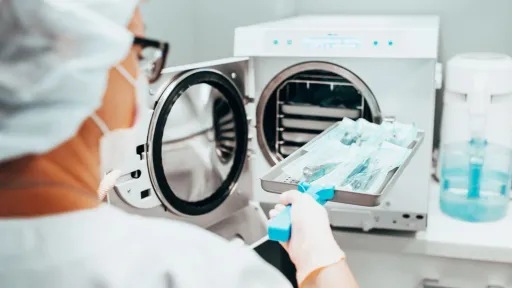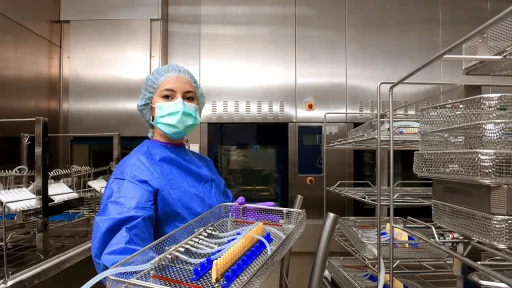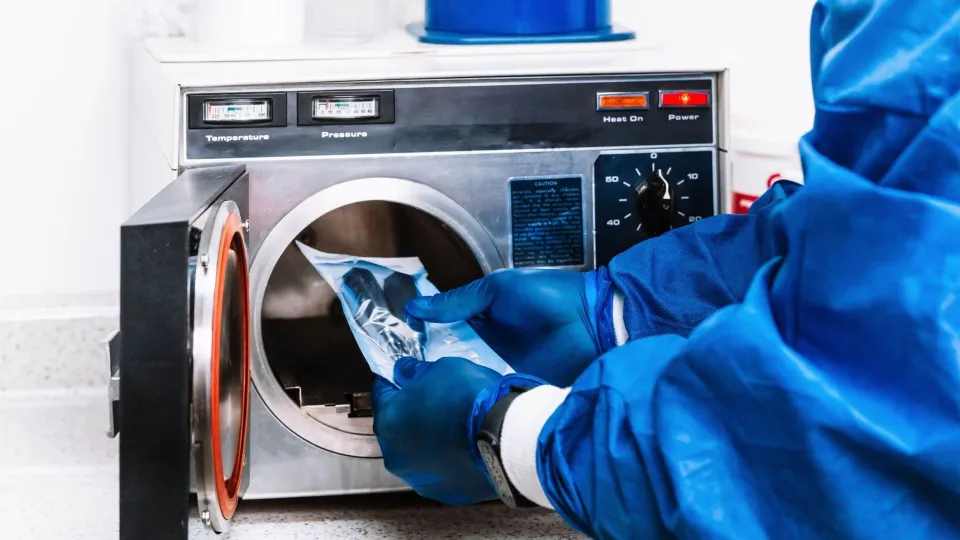
In the health care industry, sterile processing is essential to ensure that medical equipment and instruments for surgery and procedures are hygienic and well maintained. Sterile processing technicians play a vital role in avoiding infections, ensuring patient safety, and improving outcomes. The sterile processing department is considered the "heart of the hospital,".
What is Sterile Processing?

Sterile processing is the essential task of meticulously cleaning, inspecting, testing, sterilizing, storing, and tracking reusable medical instruments and devices. The cyclical process begins when used instruments are taken to the SPD for cleaning. To protect themselves from potentially infectious bacteria and avoid contaminating the equipment they're working on, SPTs wear personal protective equipment. Each device and instrument goes through a process of decontamination, sterilization, and storage. Returning the instruments and devices to the operating room for the next procedure starts the cycle once more.
Sterile processing is a life-saving career path with impacts that reach far beyond the confines of the SPD. All outcomes involving patient contact with reusable medical equipment are the responsibility of SPTs. Among these procedures are endoscopies, laparoscopic surgeries, open surgeries, biopsies, and medical device implantation. Sterile processing is critical for preventing infections associated with health care, and successful procedures aren't possible without the dedicated efforts of the sterile processing team.
SPDs have a complex role that's constantly changing as the industry adopts new technology, regulations, and best practices. Professionals in this field must frequently update their procedures to align with the latest requirements and maintain attention to detail.
The Importance of Sterile Processing in Health Care Facilities
Sterile processing is crucial to patient safety and plays a major role in the prevention of surgical site infections. Alarmingly, there was a 3% increase in 2023 in the standardized infection ratio related to the Surgical Care Improvement Project National Healthcare Safety Network operative procedure categories. Abdominal hysterectomy SSIs alone increased by 8% over this period. According to the 2023 progress report, 49 states performed better on at least three infection types compared to the 2015 baseline, and four states performed worse on at least two or more infection types.
Preventive Measures
Sterile processing is crucial for preventing infection after surgical procedures. In hospitalized patients, SSIs account for 20% of all associated infections. These infections are dangerous, increasing the chance of death by two to elevenfold. Three out of every four infection-associated deaths are attributed to SSIs.
Operational Efficiency
Sterile processing ensures the availability of safe, clean instruments. When sterilized surgical instruments are available for use, surgical procedures can be scheduled immediately, enhancing hospital efficiency. At an academic health care campus, a study of pediatric oral rehydration solutions noted that surgical instrument errors caused an average delay of 10.16 minutes.
Regulatory Compliance
To meet stringent regulatory standards, health care facility sterilization must adhere to strict sterile processing techniques. The Centers for Medicare and Medicaid and The Joint Commission have set health care guidelines for sterile processing. The law mandates CMS standards. While TJC's Centralized Sterilization Services accreditation isn't required, facilities should maintain this credential to ensure operational excellence.
Equitable Costs
SSIs are the most expensive form of heath-associated infection. These infections increase the patient's hospital stay by an average of 9.7 days, costing more than $20,000 per admission. SSIs cost an estimated $3.3 billion per year. Errors that don't result in SSIs are also costly. Delays caused by surgical instrument errors have resulted in $6.75 to $9.42 billion in billable minutes.
Key Components of the Sterile Processing Cycle

There's a strict protocol and a precise sequence to the sterile processing cycle. Careful planning went into the methods to prevent health care emergencies. SPTs must follow proper procedures at all stages to ensure effective sterilization, patient safety, and infection prevention.
Decontamination
Decontamination is the removal of microorganisms and foreign materials from an instrument. The SPT cleans the instrument with detergents or enzymatic cleaners and specialized tools such as ultrasonic cleaners, washer-sanitizers, washer-sterilizers, and washer-disinfectors. Each instrument has a set of instructions for cleaning and preparing it for sterilization.
Inspection and Assembly
Clean instruments are inspected for signs of damage or wear and tested for functionality and alignment. Technicians ensure scissors are sharp, inspect insulation on laparoscopic instruments to prevent burns, and ensure smooth motion of hinged devices.
The Association for the Advancement of Medical Instrumentation guidelines recommend assembling instruments in trays or baskets. Items with removable parts are disassembled unless instructed otherwise. Carefully positioning each item facilitates drying. Placing concave surfaces face down, hinged items open, and heavy instruments arranged correctly prevents them from shifting and damaging delicate instruments.
Packaging
The assembled instrument trays are carefully packaged for transportation to the sterilization facility. Each package is labeled with essential information, including the date, lot number, SPT's ID, and sterilization indicators.
Sterilization
Sterilizing destroys microbial life on surgical instruments. Items are arranged so that all surfaces are exposed to the sterilizing agent. Steam sterilization is the most common method, exposing instruments to high-pressure saturated steam at temperatures ranging from 250 to 273 degrees Fahrenheit. Hydrogen peroxide sterilization is often used for delicate instruments that can't tolerate steam sterilization. Temperature, pressure, and exposure time must be carefully controlled to ensure proper sterilization.
Storage and Distribution
After sterilization, instrument trays are transferred to a controlled environment where temperature, airflow, humidity levels, and cleanliness are strictly maintained to prevent contamination. Instruments spend minimal time in storage in well-organized facilities due to quick inventory rotation and timely tray preparation.
Challenges and Future Trends in Sterile Processing

The sterile processing industry is constantly changing, and professionals in this field can look forward to rapid advancements in several key areas.
Technological Advancements
The sterile processing sector is evolving quickly to use the latest technologies. System automation boosts productivity, data integration improves efficiency, and software solutions provide precise schedules for prioritizing tasks. Robotic systems are replacing jobs such as tray loading, packaging, and sterilization. This reduces the possibility of human error.
New sterilizing technologies are continually developing. UV-C radiation and advanced liquid chemical sterilization are ideal options for fragile items that require extra care. SPTs must commit to continuing education to stay at the forefront of this ever-changing field.
Related: 12 Medical Technologies You Need To Know About in the Medical Field
Educational Training
Education and certification are important in the sterile processing industry. Poorly trained technicians jeopardize quality, safety, and reliability. Currently, six states require SPT certification, and Florida, Minnesota, and Massachusetts are actively pursuing legislation or regulation for SPTs. The Healthcare Sterile Processing Association is pushing for legislation throughout the country mandating certification for these professionals.
Related: How To Become a Sterile Processing Technician: Education Preparation
Related: Sterile Processing Technician Training: Your Path to a Healthcare Career
Related: Is Sterilization Processing Technician Training Right For You?
Eco-Friendly Practices
The sterile processing industry is pursuing improved sustainability by implementing innovative waste-reduction and efficiency-enhancing practices. Efficient sterilizers, washers, and disinfectors can help save water, and energy-efficient electronic devices can reduce power consumption. Reusable instruments and equipment cut down on waste, and proper maintenance of surgical tools lengthens their life span.
Advanced Hospital Information Systems
Hospital information systems are increasingly incorporating SPDs to improve communication and workflow. Surgical asset tracking software can monitor the status and location of all tools in the hospital, allowing for data-driven workflows and unparalleled optimization. Preference card management software improves turnaround times, ensures accuracy, and provides SPTs with the tools necessary to meet surgeons' exacting demands. Automated digital records provide useful information for streamlining sterile processing procedures.
The Overwhelming Value of Sterile Processing
Sterile processing is responsible for patient safety and outcomes. Quality health care is impossible without skilled SPTs. These professionals must perform medical sterilization to exacting standards. The health care industry continues to invest in sterile processing technology, training, and best practices to improve outcomes and prevent the high number of SSIs currently occurring. Improving health care facility sterilization can have a direct impact on patient health.
The relevance of sterile processing should encourage further development for professionals in this field, and the steady growth of the health care industry as a whole is likely to promote growth in the sterile processing industry. You could become part of this essential industry by pursuing the Sterile Processing Technician program at Concorde Career College. You can complete the program in as little as five months. Successful program completion may lead to the opportunity for a rewarding career as an SPT.
Centers for Disease Control and Prevention. (2024, November 25). Current HAI progress report. Healthcare-Associated Infections (HAIs). https://www.cdc.gov/healthcare-associated-infections/php/data/progress-report.html
Centers for Disease Control and Prevention. (2025). Surgical site infection (SSI) event. National Healthcare Safety Network. https://www.cdc.gov/nhsn/pdfs/pscmanual/9pscssicurrent.pdf
Nichol, P. F., Saari, M. J., Navas, N., Aguilar, D., Bliesner, R. K., Brunner, P. J., Caceres, J. C., Chen, M., VanDommelen, A. R., Fischer, M., Garcha, S., Ghawas, E. A., Hackinson, G. R., Hitzeman, A., Jabbour, M., Jentsch, A. M., Kurth, M. M., Leyden, M., Luo, Q., & McGrain, A. C. (2024). Observed rates of surgical instrument errors point to visualization tasks as being a critically vulnerable point in sterile processing and a significant cause of lost chargeable OR minutes. BMC Surgery, 24(1). https://doi.org/10.1186/s12893-024-02407-1
Take The Next Step Towards a Brighter Future
Interested in learning more about our Sterile Processing program?
We have a Concorde representative ready to talk about what matters most to you. Get answers about start dates, curriculum, financial aid, scholarships and more!







